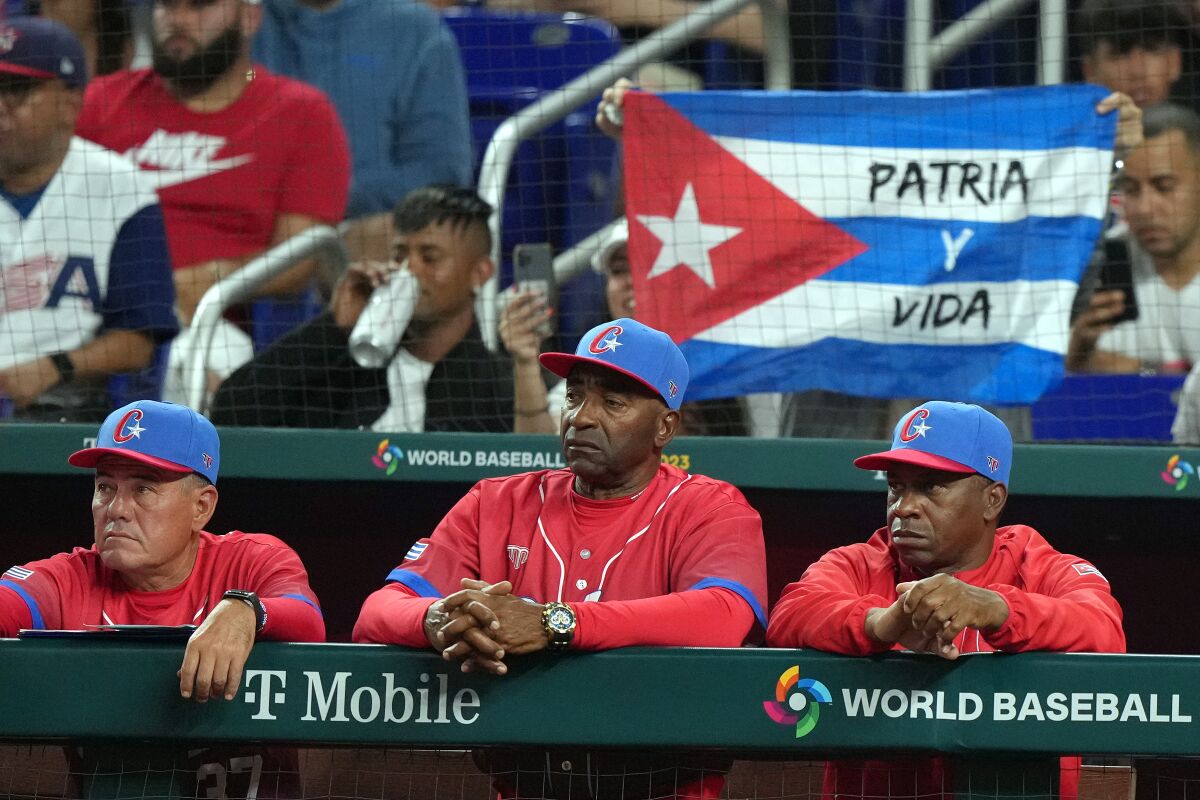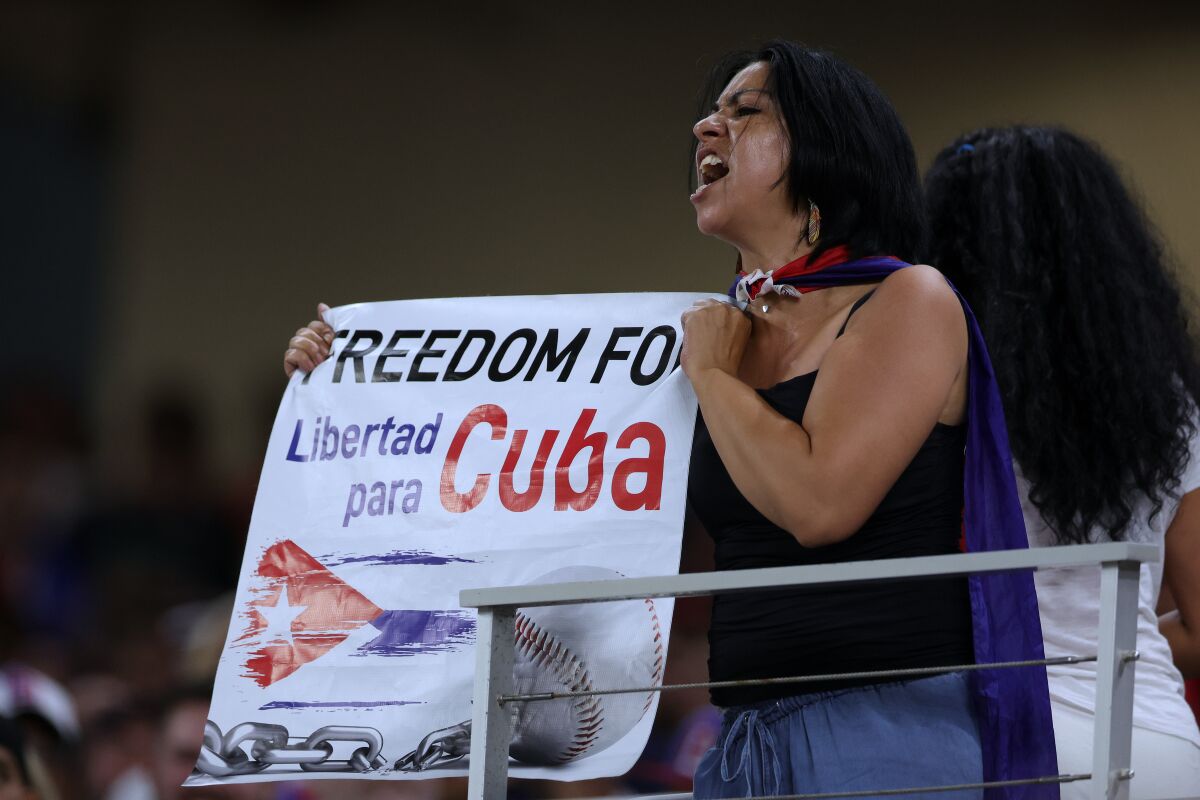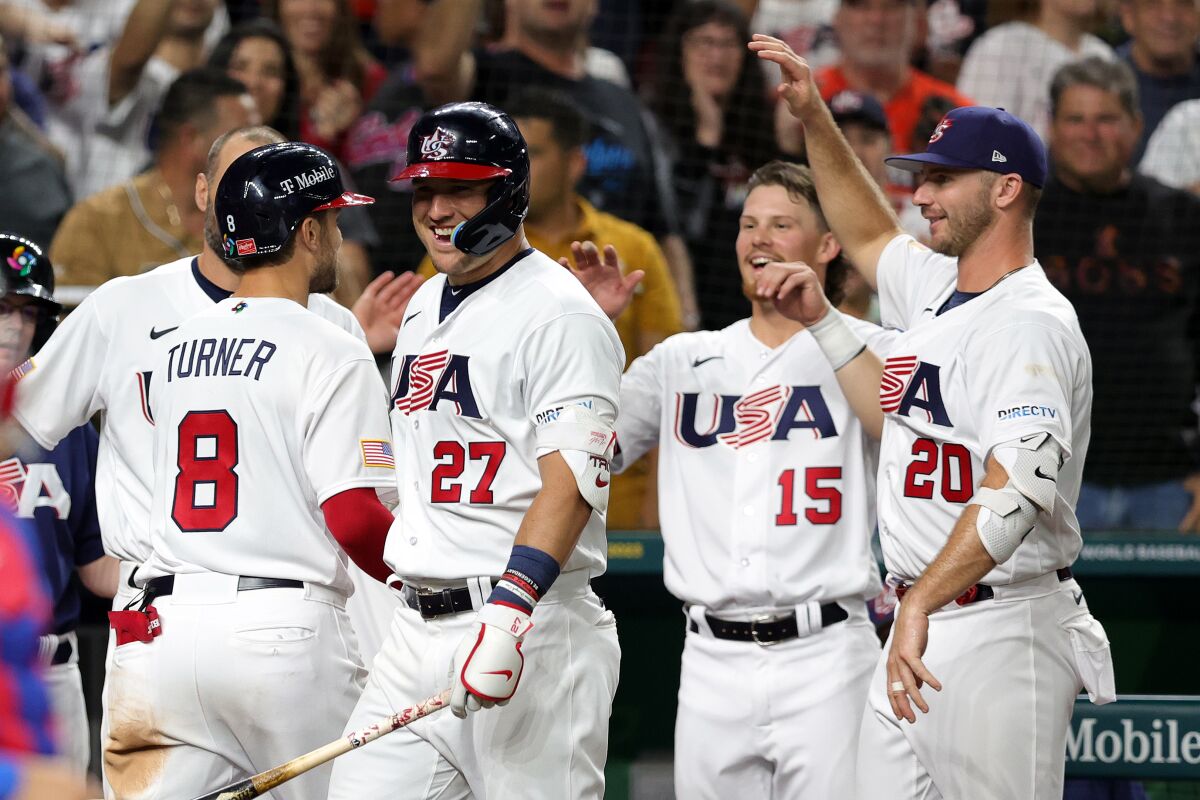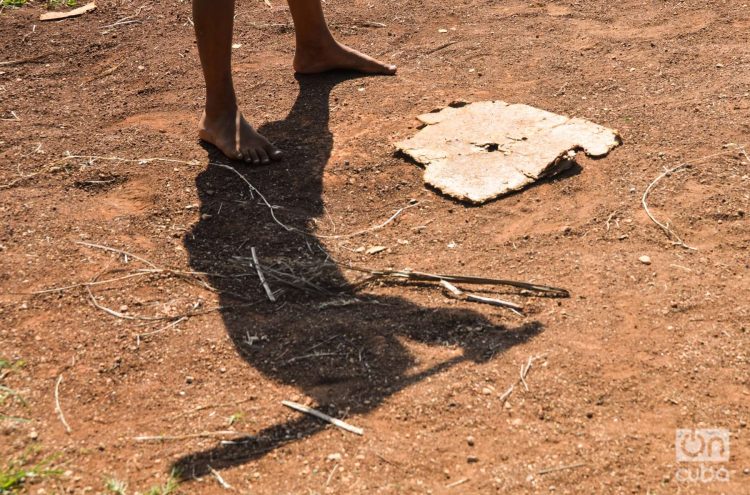Political protests transform U.S.-Cuba WBC semifinal into something beyond baseball

The sporadic “¡Libertad!” chants and the protesters running onto the field Sunday night were reminders that the World Baseball Classic semifinal between the United States and Cuba was not just another baseball game.
This was the first time the Cuban national baseball team played in Miami, home to the largest Cuban community in this country, since the Cuban Revolution ended in 1959. It was played in, of all places, Little Havana, the neighborhood Cubans made their own when they began arriving in droves. The dynamic was impossible to ignore. As was Team USA’s superiority between the lines in a 14-2 win at loanDepot Park.
Cuba took a quick 1-0 lead with three infield singles to start the game, but the U.S. dominated from there in the teams’ first WBC meeting.
Former Dodgers shortstop Trea Turner, batting ninth for the second consecutive game, led the charge, going three for four with two home runs after blasting the go-ahead grand slam in Team USA’s quarterfinal victory over Venezuela on Saturday. His four home runs in the tournament are the most for a U.S. player in a WBC. His 10 RBIs are tied for most.
In all, the Americans had 14 hits, including four home runs. They scored in every inning they batted in but the seventh. They dismantled a Cuba team that surpassed expectations reaching this point without most of the Cubans playing in the major leagues. Team USA, the tournament’s defending champion, will face Japan or Mexico, which play Monday, in the final Tuesday.
“I usually don’t hit very well here,” said Turner, who signed with the Philadelphia Phillies in December. “But I’ll take these last few days. They’ve been fun for me.”

The Cuban team that took the field Sunday was the first to feature Major League Baseball players since the country’s revolution. Chicago Cubs left-hander Roenis Elías started Sunday. The Chicago White Sox’s Yoán Moncada and Luis Robert Jr., the team’s two best position players, batted second and third. Former Dodger Erisbel Arruebarrena started at shortstop.
Each of those players took a different path back to the national team. Elías and Robert escaped Cuba by boat. Moncada was given permission to leave in 2014. Arruebarrena defected in 2013 — after a failed attempt that barred him from the Cuban National Series — and signed a $25-million contract in February 2014. He appeared in 22 games for the Dodgers that season and never reached the majors again. Five years later, he repatriated to Cuba and resumed his career there.
The Cuban team needed permission from the U.S. government — sanctions prohibit business with the country — to take part in the tournament. The Cuban Baseball Federation and players, however, weren’t allowed to receive money from the WBC, unlike the other participants.
The Cuban Baseball Federation imposed two requirements for player eligibility: Players could not have criticized the government publicly or defected during international competition to play in the United States. That left the team without several MLB veterans and stars. Some declined an invitation. Others never received one.
One of those players was Randy Arozarena. The Tampa Bay Rays outfielder defected and established residency in Mexico in 2016. Last year, he became a Mexican citizen in order to play for the country in the WBC. He has played a starring role for Mexico, helping the team reach the WBC semifinals for the first time. He told reporters after Mexico’s workout Sunday that he hoped Cuba would beat the U.S. so he could have the chance to defeat his native country in the final.

Arozarena, who attended Sunday’s game, won’t get that chance. Team USA was too much for Cuba to handle. Adam Wainwright rebounded from the strange start to the game to limit Cuba to one run over four innings. Miles Mikola, his St. Louis Cardinals teammate, followed with the same pitching line before Angels left–hander Aaron Loup finished it off.
“I’ve been focused on our pitching,” Team USA manager Mark DeRosa said. “How do we get our pitching lined up to get us in the finals day in, day out? That’s been the biggest thing. How do we honor these parent clubs, get the guys the work they need?”
The pregame news conference, usually a benign event, had a dose of tension. The room was filled with Cuban natives. Most defected to the United States from Cuba. A few others there still call Cuba home. At least one reporter was working for Granma — the official newspaper of Cuba’s Communist Party.
“Us, at this minute, are focused on what really truly matters — a game that’s going to be difficult, against a good team,” Cuba manager Armando Johnson said in Spanish. “I don’t think we’re thinking about what’s going to be said or done.”
The dynamic bled onto the field in the sixth inning when a protester emerged from the crowd. He stopped in center field, where he held up a sign that called for freedom for a group of political prisoners before security escorted him off.
Another protester scampered onto the field before the seventh-inning stretch. He eluded security guards until tripping on the infield. Another protester breached security in the eighth inning.
“I went up and asked if the run rule was still in effect here,” DeRosa said, “because I just wanted to get the guys off the field.”
“Patria y Vida” — the slogan and song linked to protests in Cuba in 2021 — was prominent on flags, signs and clothing. But the crowd was, on the whole, on the Cuban team’s side. Fans roared during pregame introductions and after the Cuban national anthem. They exploded with each hit off a Cuban’s bat. Flags waved throughout the crowd. The people were cheering for the players if not for the government they represented.
Before the game, however, protests formed outside the ballpark, beyond the building’s perimeter. One attracted dozens of people by 5 p.m.
The people gathered around photos of political prisoners and people said to have been killed under the Cuban government’s watch. A few wore red MAGA caps. Anger and the smell of cigar smoke hovered.
One man took the microphone to address the group in Spanish. He thanked the police for allowing the protest and pleaded for it to remain peaceful. His peers complied. The group swelled as first pitch approached. Periodic chants broke out.
“¡Viva Cuba libre! ¡Viva!”
“¡Asesinos!”
“USA! USA! USA!”
A few dozen feet away, on the other side of a fence, reggaeton music boomed and alcohol flowed. Fans searched for the best entrance to their seats. They arrived with mixed feelings. They left having witnessed history and a drubbing.

The ball is round… Baseball, politics and the nation
Cuba is playing the semifinal of the World Baseball Classic today, with a team made up of players from its national league and professional leagues, which has relaunched baseball as a national passion.
Photo: Kaloian.

“The passion begins”, I always heard at the beginning of the broadcasts of ball games in Cuba. "Ball" was synonymous with passion on the island for a long time, although it alluded more to sexuality. "What a ball Carlota has", said a rumba by Alberto Villalón.
Cuba is playing the semifinal of the World Baseball Classic today , with a team made up of players from its national league and professional leagues, which has relaunched baseball as a national passion.
In the best tradition, everything is discussed. Among others, the debates on the name of Team Asere for the team members, the claims not to politicize the sport, and the type of integration that the Cuban team supposes, issues that run through this text, may have a greater scope.
the asere
The name of Team Asere was born from a meme and caught on until it stayed. Some have pointed out "vulgarity" in the phrase. It is an old problem of Cuban culture and its “anxiety”, as the American academy likes to say, to account for the difficulty of accepting —and above all of including— popular and racialized expressions.
Asere is a Cuban term “loosely translatable in its use as 'brother', which means a good or trustworthy friend” 1 . For the Abakuá culture of Cuba, according to Pedro Pérez Sarduy, as in the ancient Carabalí religion, it is a form of greeting. For Sergio Valdés Bernal, its use is part of the sub-Saharan linguistic legacy in Cuban Spanish, “another identity nuance of our variant of the Spanish language” 2 .
Due to its origin, the expression has historically been marked with “vulgarity”. Juan Formell questioned many times the vision of public dances as spaces where only "the aseres", "the handsome ones" went, when, according to the founder of the Van Van, it was a cultural event of great importance for the Cuban nationality.
However, Formell's phrase has an echo throughout national history.
Dances in meeting places for the poor and blacks have always been accused of "degenerating into a scandal." A party held in 1936 in Llinás and Subirana (Havana) was dissolved by a police captain who arrested the “men and women who scandalously danced sones and rumba” for “moral offenses” 3 .
Cuban popular culture learned to deal with it. Ignacio Piñeiro composed “Los cantares del abacuá” (1923), with terms typical of that culture: “The bongó goes out of tune / If we don't sing Asere, asere, asere”. Arsenio Rodríguez sang “Los Sitios asere / they call a happy neighborhood” 4 . Both of them, together with María Teresa Vera, were the first to incorporate expressions of Afro origin in Cuban popular music, in a context in which their liturgical celebration was literally a crime, accused of "witchcraft".
Today, they are classics of Cuban national and universal culture. George Gershwin used the famous “Échale salsita”, by Piñeiro, in the introduction to his “Cuban Overture”. Arsenio is one of the founding fathers of Latin jazz. María Teresa Vera is the founding mother of the Cuban trova recognizable around the globe.
The term asere reminds us that the barracón, like the independence war and the port market, are the central sources of Cuban culture. It also happens with the terms palo (coitus), tumbadero (brothel); botar paja (masturbation) and bollo (vulva), which are transpositions of the culture of the sugar mill into Cuban popular speech 5 .
These terms are marks of the violence that gave birth to Cuban nationality, of the forms of sociability that resisted slavery, and of the centrality of racism in the production of national culture from its origins until today.
Ricardo Sánchez Porro gathers a theory according to which the term lukumí , used in Cuba to identify even different cultural expressions, perhaps "obeys the treatment between equals that the Yoruba gave themselves", which is "as saying asere nowadays" 6 .
The current use of asere perhaps expresses like no other word —señor, compañero, míster, pana— the demands for equality and inclusion, for equal treatment, in today's Cuba, and the complexities of how to achieve it.
The “politicization” of sport
The first official ball club arose in Cuba in 1868. The first competition was held in 1878. It is the period of the Great War. Its diffusion in Cuba responded to a political context: the image of American modernity, and not the reality of Spanish colonial oppression, should provide, says Lisandro Pérez, the desirable symbols for a nascent nationality committed to a "clearly modernist, progressive orientation." and secular” 7 .
The most prominent of those symbols was baseball, which quickly became filled with Cubanisms that were rarely translated from English, such as "ponche."
The Cuban emigration in New York in the 19th century, as soon as he learned English, says Jesse Hoffnung-Garskof, discussed baseball while paying homage to Maceo 8 .
A cartoon —reminiscent of the name "old cat" for the ball—reveals the Spanish animosity towards baseball, its association with the United States and the political references that baseball's phrases kept against the colonial regime.
On the other hand, baseball, especially professional baseball—amateurism was for decades an aristocratic luxury, which made Kid Chocolate exclaim, in the boxing field, that he couldn't afford to be an Olympic champion—was a channel for social mobilization.
It represented one of the few avenues available for poor people to "get ahead" as well as dignify the "black race." This is how the anti-racist movements of the first half of the 20th century celebrated Cuban and foreign athletes such as Kid Charol, Black Bill, José — the Black Diamond — Méndez, or Jesse Owens.
Roberto González Echeverría has shown another facet of the nationalist politicization of baseball in Cuba, by studying the emergence of players from the interior of the country in the 1930s and 40s, who embodied “an ideal type of the Republic” 9 .
Those players were guajiros, the mythical site of the "redeeming bush." They represented “a kind of amateur aristocracy”, used by the nationalism reworked in Cuba after the revolution of 1930. “El Guajiro de Laberinto”, Conrado Marrero, was one of them.
Part of this process was the 1940 Constitution, the first, perhaps in the world, to recognize racial discrimination as a punishable crime, and to ensure affirmative action mechanisms for discriminated sectors.
The ball played a role here: the Sports Directorate was required, in Prío's time, to put an end to "discriminatory practices in amateur sports and especially in baseball, where the exclusion of blacks became a ' scandal'” 10 .
That is, the link between politics and baseball is well established in Cuban history. It by no means started in 1959.
The integration of the team to the Classic: politics and sport
The conformation of the current team is not the first conflictive integration that Cuban baseball has experienced in its history.
Cuba had an integrated team, black and white, 47 years before the United States. After 1908, José de la Caridad Méndez “was the first great popular idol of sports in Cuba, recognized by whites and blacks” 11 . Another Cuban, Silvio Garcia, may have preceded Jackie Robinson in breaking the color barrier in baseball in that country.
For Ada Ferrer, “many members of the segregated Negro Leagues in the United States loved to play baseball in Cuba. They could play all their games in world-class integrated stadiums, in a beautiful and fascinating city, without having to suffer the humiliations they suffered in the past of the Jim Crow era” 12 .
After the triumph of the Cuban Revolution in 1959, the complete integration between whites and blacks took place on the ball. It happened in 1962, at the beginning of the national series that abolished professionalism (which allowed black players), while denying the tradition of Cuban amateurism in baseball, and its frequent refusal to accept blacks 13 .
Since then, another kind of “disintegration” began. It is the one that is being discussed today about the current team to the Classic: that of the former Cuban professional baseball players —prohibited at that time from playing baseball in Cuba—, of the Cuban League with respect to professional leagues, and of the cancellation, stigmatization and exclusion of those who played in them.
The succession of successes of this new era was widely celebrated in Cuba, while its competitive prestige strengthened in the world, although under the shadow, not always fair, of not playing against "the best."
The Cold War also provided context: the use of sport as a State policy to affirm the superiority of a system, in a competition that did not leave any of the contenders unscathed 14 . Cuba, in its scale, was part of this global process of instrumentalization of sport, in its case as a socialist achievement and a nationalist victory.
In 2023, the situation is very different. If, as González Echeverría says, “the symbolism of scoring in baseball is as complicated as a modernist metaphor”, the symbolism of this Clásico, and of the integration of the team, is as complicated as the current Cuban political grammar.
Metaphors and consequences of Team Cuba
El Clásico has generated many symbols, both articulations and contradictions, and perhaps it will yield results for the future.
For its part, the Cuban government took the first, essential and long-desired step in the integration of professional baseball players. With all its problems (the exclusion of Yasmani Tomás is the most scandalous slab of the selective integration criteria), it is also a good metaphor for national integration. There should be no going back.
On the other hand, the agreement with the MLB was suspended by Trump. The result of the Clásico may prompt demands to resume the agreement, also from the United States.
Some eight of the 30 players on the team play only in Cuba. It was hard to expect this to be a “normal” integration. However, they have coexisted with each other, and celebrated their triumphs with songs from a shared national soundtrack, until now without news that a civil war has broken out in the locker room.
Cuban contradictions have also made an appearance:
The Cuban government has eagerly accepted the name of Team Asere. However, in 2021, in the face of popular protests, he did not hesitate to call a very large number of "aseres" "vandals and criminals" —the racialized background of these protests does not go unnoticed—, a significant part of whom have been imprisoned to this day with very disproportionate penalties.
On the other hand, the fundamentalist areas of Cuban exile reject the idea of Team Asere, as if all its members were until today Moncadista pioneers. In this, they have called for a boycott of games and wished for the defeat of the team that “does not represent them”, when there are their idols among them when they play in the MLB.
El Clásico has misplaced many compatriots, which may be part of a more general misplacement about what to do in and with Cuba. Now, no tradition becomes national by choice, nor has it been deployed for 150 years without generating consequences and possibilities.
In a documentary by Rolando Díaz, an amateur assures: "it is that everything that the people like is round and square." Hearing him, seeing his face when he says it, explains the best declaration of love, and wisdom, that I have heard both about the ball, and about the core of a national policy that deserves to bear that name.
Grades:
1 Afrocuba. An Anthology of Cuban writing on race, politics and culture , Edited by Pedro Pérez Sarduy and Jean Stubbs, Ocean, Published in association with the Center for Cuban Studies (New York), 1993, p. 157.
2 Sergio Valdés Bernal, «Oh, what happiness! How I like to speak Spanish!», in Catauro . Cuban Journal of Anthropology. Year 4, number 6. 2002, p.95.
3 “Three detained by the national police, moral offenses.” The Crucible. 26.12.1936.
4 The texts of both songs appear in the compilation, in two volumes, ¡Oh Cuba Hermosa! The social political songbook in Cuba until 1958, by Cristobál Díaz-Ayala.
5 Manuel Moreno Fraginals. The wit. Social economic complex of sugar, Editorial de Ciencias Sociales, Havana, 1986, p. 40.
6 Reinaldo Sanchez Porro. "History of the main African ethnic groups brought to Cuba", in Black presence in Cuban culture, Coordination and introduction by Denia García Ronda, Ediciones Sensemayá, Havana, 2015, p.30
7 Lisandro Perez. Sugar, Cigars, and Revolution The Making of Cuban New York, New York University Press, New York, 2018, p. 6
8 Jesse Hoffnung-Garskof. Racial Migrations: New York City and the Revolutionary Politics of the Spanish Caribbean , Princeton University Press, Year: 2019, p. 154.
9 Roberto González Echevarría, Cuban baseball players. Three testimonies, Nueva Sociedad No. 154 March-April 1998, pp. 87-100, see also Gloria de Cuba: History of baseball on the island, Editorial Colibrí, Madrid, 2004.
10 Alejandro de la Fuente, A Nation for All: Race, Inequality, and Politics in Cuba, 1900-2000. Madrid, Spain: Editorial Colibrí, p. 308.
11 Felix Julio Alfonso and Victor Joaquin Ortega. «Black Cuban athletes in the Republic», in Black presence in Cuban culture, Coordination and introduction by Denia García Ronda, Ediciones Sensemayá, Havana, 2015, p.264.
12 Ada Ferrer. Cuba. An American history , Scribner, 2021, p. 223.
13 Felix Julio Alfonso and Victor Joaquin Ortega. Ob. cit.
14 This is a brief reminder of this: The German Federal Republic (GDR) certified its cultural birth as a new nation, after World War II, with the conquest of the soccer world championship in 1954. The USSR celebrated, after much scandal, the triumph of his Olympic basketball team in 1972, against the sport of “imperialism”. In the United States, they celebrated the victory at the 1980 Winter Olympics of their non-professional hockey team over the USSR, nicknamed none other than the “Red Army”, as if it were the final victory over communism. The GDR imposed a model of mass surveillance on athletes, and state doping practices. The latter, with less fame, were also organized in that context by the United States.
**************************************
PROGRESO WEEKLY: Inclusión is the Key
Walter Lippmann Mar 19 #23031  Inclusion: The keyThe stubborn reality, like the mangrove swamp, seems – I am prudent – to have been imposing itself.By Progreso Weekly On Mar 19, 2023 Here, There and Everywhere javier toledo Translated by Walter Lippmann for CubaNews. Thee expected baseball game this afternoon between the teams (teams) Asere Cuba and the United States in the afternoon today, has moved the ground on both shores. Opinions, comments, of all kinds, radicalization of positions, especially in Miami, etc. There is everything, like in an apothecary, demanding the attention of sociologists and psychosociologists so that they carry out a serene study of what is happening and is happening on each side of the 90 miles from the situation created by a baseball game. Some argue for linguistic delicacies about the use of Asere-Cuba, merged, intertwined, imbricated, exceed, in my opinion, an important moment. Let me explain: Asere, monina, ecobio, ambia, they are worth a friend, acquaintance, partner. And it happens that for the first time the Cuba team is made up of players from the country and by Cubans who emigrated and play in foreign leagues. It hadn't happened before. Asere=friend, not enemy, not stranger, you=Cuba Cuban, regardless of what you think in political terms because some of our baseball players, Cubans like you, me, that other one, do not sympathize with the Cuban government, but they are from the team , of the team They are Cuban. Cuba is more than a government. The key to the success achieved in being in the big four lies in the option to INCLUDE to win. The stubborn reality, like the mangrove, seems – I am prudent – to have been imposing itself. And curious: the exclusions "swarm" (abundant) in Florida right now, not only in the networks, but at political levels where they have even explored the possibility that the Cuba-Asere team be prohibited from playing at the LoanDepot Park in Miami ; or find out if any of the players who play in the US MLB have violated the law by joining the Cuba-Asere team. Regardless of the result of today's game, the Cuba team has already won by reaching the semifinals and it is worth insisting that a key point has been the inclusive policy. Hopefully INCLUDE, a positive experience, will be fully extended to all areas of national life. Photo taken from Jit Progreso Semanal/ Weekly authorizes the total or partial reproduction of the articles by our journalists as long as the original source and author are identified. Follow us on Facebook , on Twitter @ProgresoHabana and on Telegram .
|

No comments:
Post a Comment